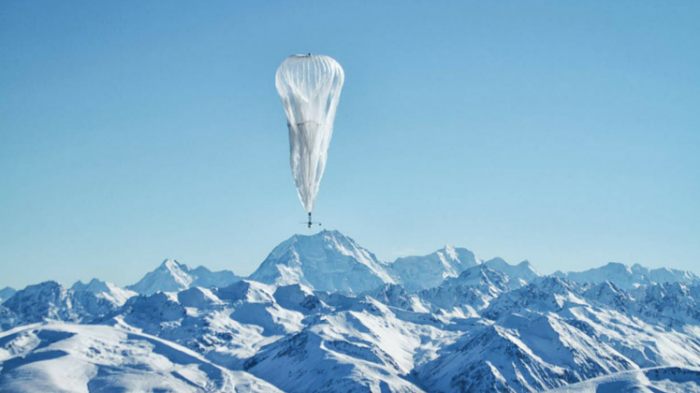Two weeks ago, a press conference was organized by the Ministry of Telecommunication & Digital Infrastructure. It was at this press conference that Hon. Minister Harin Fernando announced that Project Loon would commence its trials in Sri Lanka, with the Ratmalana airport acting as a landing base. In case you’ve been living under a rock, Project Loon is an initiative by Google to bring The Internet to everyone through the use of balloons. Thanks to the ICTA, a MoU was signed with Google to bring Project Loon to Sri Lanka.
Yesterday, the first of these Project Loon balloons entered Sri Lankan airspace. To be precise, they were located on the Southern Coast of Sri Lanka. With the balloon and testing equipment now being in Sri Lanka, tests are expected to commence soon.
As we’ve covered before, these helium balloons will be flying high above the clouds in the stratosphere. This means they’ll be flying higher than commercial airplanes and bird life. At this altitude, they’ll be acting as miniature mobile cellular towers in the sky for 100 days. As such, the balloons will be taking signals from existing ISPs and beaming them down to areas without internet access.
At the moment, only one such balloon is in Sri Lanka for testing purposes. As the tests progress, we will likely see more Project Loon balloons fill the sky. Eventually, when Project Loon comes closer to its final implementation date, we can expect 13 such balloons to fill the sky. It’s nice to see that Project Loon is coming closer to implementation in Sri Lanka. Hopefully, at the end of the year, we will actually have fast balloon internet covering the entire island.







මෙය තනිකරම අපේ රටේ තොරතුරු හොරෙන් ගන්න ගහපු ගැටයක්. මෙම බැලූන් වලට අමුණා ඇති උපකරණ මගින් 4G LTE නමැති අධිවේග රැහැන් රහිත දත්ත හුවමාරු කරන තාක්ෂනය හරහා සීමිත පිරිසකට අනතර්ජාල සේවා සැපයිය හැක. ලංකාවේ සාමාන්ය ජනතාවගෙන් කී දෙනෙකුට 4G තාක්ෂනය සහිත ජංගම උපකරණ තිබේද?. එදිනෙදා ජීවිතය පවත්වාගෙනයාම සඳහා පොරබදන ලාංකීය පොදු ජනතාවට මෙයින් ලැබෙන්නේ මොනවාද?. මෙය ඔවුන්ගේ මූලික ප්රශ්න විසදීමක්ද? දැනටමත් ලංකාවේ ක්රියාත්මක වන අන්තර්ජාල සපයන ආයතන මුළු රටම ආවරණය කර ඇති මොහොතක මෙයින් ජනතාවට ලැබෙන විශේෂ වාසිය කුමක්ද?
එක් බැලූනයක් මගින් වර්ග කිලෝමීටර 5000 ප්රමාණයක් ආවරණය කල හැකි බවට පැවසුවද එමගින් එකවර සැපයිය හැක්කේ අන්තර්ජාල සබඳතා සිය ගණනක් පමණි. ගූගල් ලූන් වෙබ් අඩවියේම මෙය සඳහන්ව ඇත. ඒ අනුව බැලූන් 13 මගින් ලංකාවම ආවරණය කලද ලබාදිය හැකි සම්බන්දතා ගණන ඉතා අඩුය. එමෙන්ම මෙම බැලූන සඳහා අන්තර්ජාල සම්බන්දතාවය ලබාදිය යුත්තේ අන්තර්ජාල සේවා සපයන සමාගම් මගිනි.මෙසේ ලබාදෙන සම්බන්ධතාවයේ ධාරිතාව බැලූනය හා 4G තාක්ෂණයෙන් සම්බන්ධවන පුද්ගලයන් අතර බෙදී යන බැවින් අන්තර්ජාලයට සම්බන්ධවියහැකි වේගය ඒ අනුව තීරණය වේ.
ගූගල් ලූන් තාක්ෂනය 2013 වසරේදී නවසීලන්තයේදී පමණක් අත්හදා බැලීම් කරන ලද , වෙනත් කිසිම ආකාරයෙන් අන්තර්ජාල සේවා සැපයිය නොහැකි භූමි ප්රදේශවල සිටින සීමිත පිරිසකට අන්තර්ජාල සේවා සැපයීම සඳහා භාවිතයට යෝජනා කර ඇති ක්රමයකි. මෙයට උදාහරණ ලෙස කඳුකර ප්රදේශ , කාන්තාර නම් කල හැක. දින 100කට වරක් නැවත නැවත බැලූන යැවිය යුතුය.වෙනත් කිසිදු රටක් මෙම තාක්ෂනය පාවිච්චි නොකරන්නේ එය වියදම් අධික බැවිනි. අධික මිලකින් යුත් මෙවැනි බැලූන ඇමෙරිකාවේ සිට මෙරටට නොමිලේ එවන්නේනම් එය පිටුපස ඇත්තේ කුමක්දැයි සොයා බැලිය යුතු කාරණාවකි.ඇමෙරිකානු සමාගමකට තම ගුවන් සීමාවේ රිසිසේ බැලූන හසුරවා ඔත්තු බැලීමට ඉඩදෙන ලෝකයේ පළමු මෝඩයන් සිටින රට බවට අපි පත්ව ඇත්තෙමු.
මෙම ව්යාපෘතිය ක්රියාත්මක කිරීම සඳහා ඇමතිවරුන් කිහිපදෙනෙකු නිතර නිතර විදෙස් ගත වන අතර ඔවුන්ගේ හිතවතෙකු මේ සඳහාම ආයතනයක් ලියාපදිංචි කර ඇත්තේ කුමක් සඳහාදැයි සිතීම ඔබට බාරය. අවසානයේ මෙම සියල්ලේ බරපැන විදීමට සිදුවන්නේ රටේ සාමාන්ය ජනතාවටයි. තොරතුරු තාක්ෂණ නියෝජිතායතනයට ක්රියාත්මක කිරීම සඳහා ජනතාවට ප්රයෝජනවත් වන වෙනත් ව්යපෘති ඇත්තේම නැද්ද?